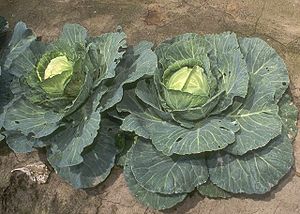Cruciferous vegetables facts for kids
Cruciferous vegetables are a special group of vegetables from the plant family called Brassicaceae. You might also hear this family called Cruciferae. There are many different kinds of plants in this family that we grow and eat. Some common ones include cauliflower, cabbage, kale, garden cress, bok choy, broccoli, Brussels sprouts, and mustard plant.
The name "Cruciferae" comes from the Latin word for "cross-bearing." This is because the flowers of these plants have four petals that look like a cross.
Many of the most popular cruciferous vegetables, like cabbage and broccoli, actually come from just one species called Brassica oleracea. Even though they look very different, they are all part of the same plant species. Farmers have used selective breeding to create all these different types from one original plant. In North America, these are often called cole crops, and in the UK, Ireland, and Australia, they are known as brassicas.
Cruciferous vegetables are super important food crops around the world. They are packed with good things for you, like vitamin C and fiber. They also have many other nutrients and special plant chemicals that are good for your health.
Discovering Cruciferous Vegetables
Farmers have worked hard over many years to create a huge variety of cruciferous vegetables. This is especially true for plants in the Brassica group. A cool way to understand how different Brassica species are related is through something called the Triangle of U.
| common name | genus | specific epithet | Cultivar group |
|---|---|---|---|
| Horseradish | Armoracia | rusticana | |
| Land cress | Barbarea | verna | |
| Ethiopian mustard | Brassica | carinata | |
| Kale | Brassica | oleracea | Acephala group |
| Collard greens | Brassica | oleracea | Acephala group |
| Chinese broccoli (gai-lan / jie lan) | Brassica | oleracea | Alboglabra group |
| Cabbage | Brassica | oleracea | Capitata group |
| Savoy cabbage | Brassica | oleracea | Savoy Cabbage group |
| Brussels sprouts | Brassica | oleracea | Gemmifera group |
| Kohlrabi | Brassica | oleracea | Gongylodes group |
| Broccoli | Brassica | oleracea | Italica group |
| Broccolini | Brassica | oleracea | Italica group × Alboglabra group |
| Broccoflower | Brassica | oleracea | Italica group × Botrytis group |
| Broccoli romanesco | Brassica | oleracea | Botrytis group / Italica group |
| Cauliflower | Brassica | oleracea | Botrytis group |
| Wild broccoli | Brassica | oleracea | Oleracea group |
| Bok choy | Brassica | rapa | chinensis |
| Komatsuna | Brassica | rapa | perviridis or komatsuna |
| Mizuna | Brassica | rapa | nipposinica |
| Rapini (broccoli rabe) | Brassica | rapa | parachinensis |
| Choy sum (Flowering cabbage) | Brassica | rapa | parachinensis |
| Chinese cabbage, napa cabbage | Brassica | rapa | pekinensis |
| Turnip root; greens | Brassica | rapa | rapifera |
| Rutabaga (swede) | Brassica | napus | napobrassica |
| Siberian kale | Brassica | napus | pabularia |
| Canola/rapeseed | Brassica | rapa/napus | oleifera |
| Wrapped heart mustard cabbage | Brassica | juncea | rugosa |
| Mustard seeds, brown; greens | Brassica | juncea | |
| White mustard seeds | Brassica (or Sinapis) | hirta | |
| Black mustard seeds | Brassica | nigra | |
| Tatsoi | Brassica | rosularis | |
| Wild arugula | Diplotaxis | tenuifolia | |
| Arugula (rocket) | Eruca | vesicaria | |
| Field pepperweed | Lepidium | campestre | |
| Maca | Lepidium | meyenii | |
| Garden cress | Lepidium | sativum | |
| Watercress | Nasturtium | officinale | |
| Radish | Raphanus | sativum | |
| Daikon | Raphanus | sativum | longipinnatus |
| Wasabi | Wasabia | japonica |
Plants in the Brassicaceae family are also grouped into larger families called tribes. For example, Armoracia (horseradish), Barbarea (land cress), and Nasturtium (watercress) belong to the Cardamineae tribe. Brassica (like cabbage and broccoli), Sinapis (mustard), Diplotaxis (wild arugula), Eruca (arugula), and Raphanus (radish) are in the Brassiceae tribe. Lepidium (garden cress) is in the Lepidieae tribe, and Wasabia (wasabi) is in the Eutremeae tribe.
Interesting Facts About Taste
Have you ever noticed that some people find certain vegetables bitter, while others don't? This can happen with cruciferous vegetables! Some people have a special gene that allows them to taste a chemical called phenylthiocarbamide (PTC). If you can taste PTC, it often tastes bitter.
The chemicals that give cruciferous vegetables their unique flavor, called isothiocyanates, are similar to PTC. So, if you can taste PTC, you might find vegetables like broccoli or Brussels sprouts taste more bitter than someone who can't taste PTC. It's all about your taste buds!
See also
 In Spanish: Verduras crucíferas para niños
In Spanish: Verduras crucíferas para niños


